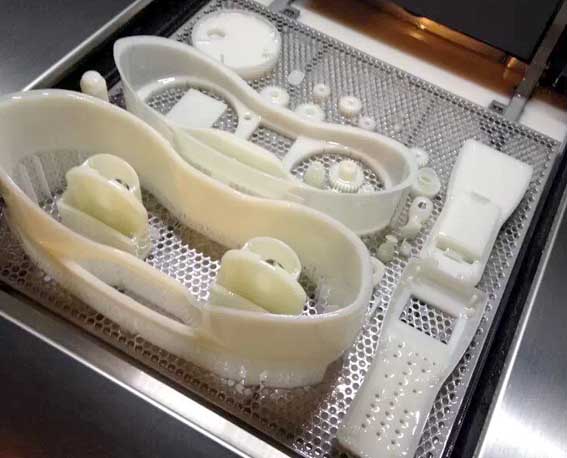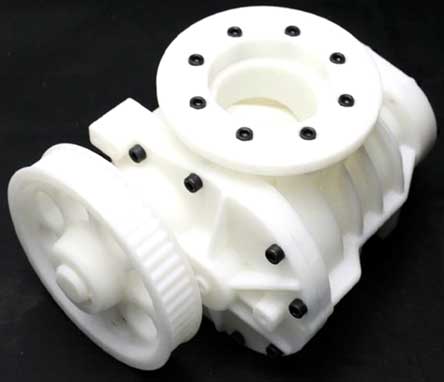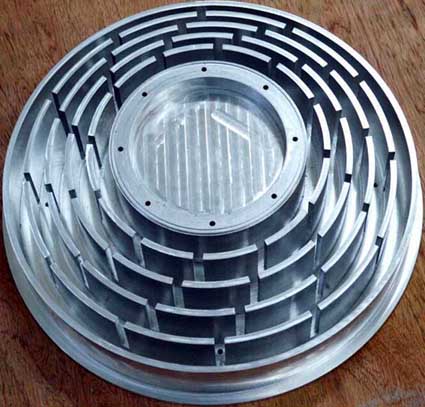Material classification and production process of rapid prototype

Prototype material classification
a, ABS (domestic, imported, transparent, black, ultra-high temperature resistance, etc.)
b. 475 rubber sheet, bakelite, plastic king, etc.
c. POM (Saigang), PMMA (Acrylic), PC, PP, PA, BT, PVC, etc.
d. Aluminum, copper, other alloys
In addition, prototypes are generally produced by 3D printing technology abroad, which is a very mature market. The prototype can also be called: model, etc., often called in English: prototype, model.
Prototyping process
(1) Inspection design
The prototype is not only visible but also touchable. He can intuitively reflect the designer's creativity in the form of real objects, avoiding the disadvantage of "drawing is good-looking but not good-looking". Therefore, prototyping is indispensable in the process of new product development and product shape scrutiny.
(2) Inspection structure design
Because the prototype can be assembled, it can intuitively reflect the rationality of the structure and the ease of installation. Facilitate the early detection and resolution of problems.
(3) Avoid the risk of opening the mold directly
Because the cost of mold manufacturing is generally very high, relatively large molds are worth hundreds of thousands or even millions. If you find that the structure is unreasonable or other problems in the process of processing the mold, the loss can be imagined. Prototyping can avoid this loss and reduce the risk of mold opening.
(4) Make the time to market of products greatly advance
Because of the advanced nature of prototyping. You can use the prototype as a product promotion before the mold is developed, and even pre-sales, production preparation, and early market occupation.

SLA is a process that uses the principle of Stereolithography, also known as selective curing of photosensitive resin, and is the earliest rapid prototyping technology. The process is: The resin tank is filled with liquid photosensitive resin, which will quickly cure under the irradiation of the ultraviolet laser beam. At the beginning of the molding process, the liftable table is at the height of the next layer thickness of the liquid surface. The focused laser beam is scanned along the liquid surface under the control of the computer according to the requirements of the cross-sectional profile. The resin in the scanned area is cured to obtain a resin sheet of this cross-sectional profile. Then, the table is lowered by the height of a thin layer, and the cured resin thin layer is covered with a new layer of liquid resin for the second layer of laser scanning and curing. The newly cured layer is firmly bonded to the previous layer, and this is repeated until the entire product is formed. Finally, cleaning, removing support, secondary curing and surface finishing treatment are carried out.
(1) Inspection design
The prototype is not only visible but also touchable. He can intuitively reflect the designer's creativity in the form of real objects, avoiding the disadvantage of "drawing is good-looking but not good-looking". Therefore, prototyping is indispensable in the process of new product development and product shape scrutiny.
(2) Inspection structure design
Because the prototype can be assembled, it can intuitively reflect the rationality of the structure and the ease of installation. Facilitate the early detection and resolution of problems.
(3) Avoid the risk of opening the mold directly
Because the cost of mold manufacturing is generally very high, relatively large molds are worth hundreds of thousands or even millions. If you find that the structure is unreasonable or other problems in the process of processing the mold, the loss can be imagined. Prototyping can avoid this loss and reduce the risk of mold opening.
(4) Make the time to market of products greatly advance
Because of the advanced nature of prototyping. You can use the prototype as a product promotion before the mold is developed, and even pre-sales, production preparation, and early market occupation.

Prototype processing method
CNC prototype according to the processing method: It is divided into laser rapid prototyping (SLA / SLS) and CNC processing, both of which have their own special processing materials.
1. Laser rapid prototyping (SLA / SLS)
Laser rapid prototyping is divided into SLA and SLS by the difference of raw materials.
CNC prototype according to the processing method: It is divided into laser rapid prototyping (SLA / SLS) and CNC processing, both of which have their own special processing materials.
1. Laser rapid prototyping (SLA / SLS)
Laser rapid prototyping is divided into SLA and SLS by the difference of raw materials.
SLA is a process that uses the principle of Stereolithography, also known as selective curing of photosensitive resin, and is the earliest rapid prototyping technology. The process is: The resin tank is filled with liquid photosensitive resin, which will quickly cure under the irradiation of the ultraviolet laser beam. At the beginning of the molding process, the liftable table is at the height of the next layer thickness of the liquid surface. The focused laser beam is scanned along the liquid surface under the control of the computer according to the requirements of the cross-sectional profile. The resin in the scanned area is cured to obtain a resin sheet of this cross-sectional profile. Then, the table is lowered by the height of a thin layer, and the cured resin thin layer is covered with a new layer of liquid resin for the second layer of laser scanning and curing. The newly cured layer is firmly bonded to the previous layer, and this is repeated until the entire product is formed. Finally, cleaning, removing support, secondary curing and surface finishing treatment are carried out.
The photosensitive resin selective curing rapid prototyping technology is suitable for making small and medium-sized workpieces, and can directly obtain resin or similar engineering plastic products. The surface quality of SLA rapid prototyping is good, the system resolution is high, and the forming accuracy is high.
The processing method of SLS is similar to SLA technology, but the liquid photopolymer is replaced with powder raw material, and the powder material is acted on with a certain scanning speed and energy. In the forming process, the laser parameters, the characteristics of the powder and the sintering atmosphere are important factors affecting the quality of the sintering. SLS rapid prototype can produce the hardest prototype, and can use a variety of raw materials, such as most engineering plastics, waxes, metals, ceramics, etc. The construction speed of the parts is high, there is no need to post-correct the parts, and there is no need for design and structural support.
2. CNC rapid prototyping
CNC is widely used in mechanical processing industry, and the technology is relatively mature. Used for prototype processing. The effect and accuracy are also very good, first consider the prototype processing method.






